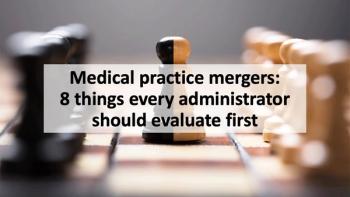
Physician group post-merger integration
In order to be successful, a merger must be followed up with a detailed course of action.
Closing the deal is a major milestone, but it’s the process that follows where the real value is created. It may be difficult to believe, but the post-merger integration can be even more complicated than the deal itself. Communication is critical during this process, and the two groups need to share documents easily. Information must be transitioned seamlessly throughout, and the whole integration process has to meet physician owners’ expectations for key timelines and capturing synergies in growth and costs.
Taking proactive action within the first 100 days post-closing can significantly realize deal synergies and potential. Practice administrators working in concert with a seasoned consultant must develop a well-structured plan for their post-merger integration efforts to vastly improve their odds for a successful outcome.
The complexities of integration
Many physician owners spend months of time and effort closing merger transactions but stumble when it comes to integration. Oftentimes, buyers significantly underestimate the necessary level of involvement in a successful integration effort. Common mistakes include:
- Failing to properly assess the resources to integrate and operate two businesses
- Not addressing “people issues” and cultural differences of the physician groups
- Losing focus after the signing of a deal
- Overloading management with integration responsibilities outside their scope of expertise
These mistakes lead to a significantly slower integration effort that tends to compound these and other mistakes.
Speed is of the essence
Physician groups that move slowly during the integration process are vulnerable both financially and competitively. The announcement of a merger between two groups creates uncertainty among employees of both organizations and fuels anxiety-filled discussions about who will stay and who may be let go. Without proactive and effective communications, employee morale will suffer. Even worse, those key employees who you hope to retain may jump ship to competitors or other organizations.
The turbulence of an announced merger can give competitors a perfect opportunity to call on your referring physicians and even patients. The community at large can spread all kinds of unconfirmed “alternative facts.” A slow response to retention initiatives (retention of employees, patients, and referring physicians) during a merger can leave competitive doors open too wide for too long. Decision-making must be streamlined for the integration effort to move forward. The completion of a few “quick win” integration tasks will bolster confidence in the team leadership and keep the process moving forward. One of the first things to do is host a staff meeting to discuss key human resource issues such as payroll schedule and benefits transition.
A plan of action
Strategic integration decisions should be put in place prior to the completion of due diligence because these strategic decisions may influence the deal terms and structure. It’s important to identify these details and include them into the deal agreement before closing. Ideally, a 100-day integration plan is implemented when the deal closes. This should include identifying tasks to be completed, known issues, milestones, and planned timelines for completion.
Following the deal’s closing, detailed planning sessions should begin with functional department members of both practices. In the beginning stages, joint meetings are essential to establish relationships between representatives of both practices. Once initial on-site discussions are completed, subsequent discussions leveraging virtual meeting technology can take place. The two together will result in more efficient time utilization and reduced travel costs.
If you think of a physician group merger as a marriage, then you can see there is still a lot of work left to do after the wedding date, or day 1. Yes, it’s the day in, day out effort of the marriage that takes patience and thoughtfulness-and also tends to get messy. Compared to a marriage, the wedding is easy. Post-merger integration is critical to realizing the value of a deal. It’s also highly complex, taking place under severe time pressure, and happens in parallel to running the core business-making it one of the most challenging initiatives physician owners and practice administrators will ever undertake.
What's the secret to post-merger integration success? Focus on the strategic objectives of the deal, accelerate synergies, and building a high-performance medical practice.
Nick Hernandez, MBA, FACHE, is the CEO and founder of ABISA, a consultancy specializing in strategic healthcare initiatives for physician practices. His firm helps devise and implement strategies that will allow practices to remain competitive and solvent. E-mail him
Newsletter
Optimize your practice with the Physicians Practice newsletter, offering management pearls, leadership tips, and business strategies tailored for practice administrators and physicians of any specialty.














